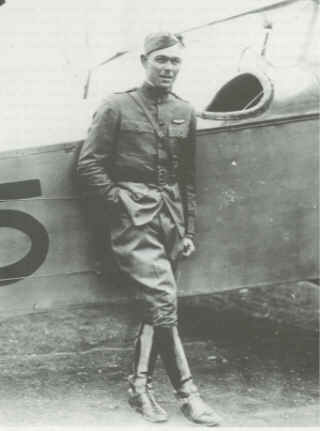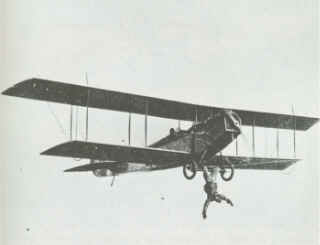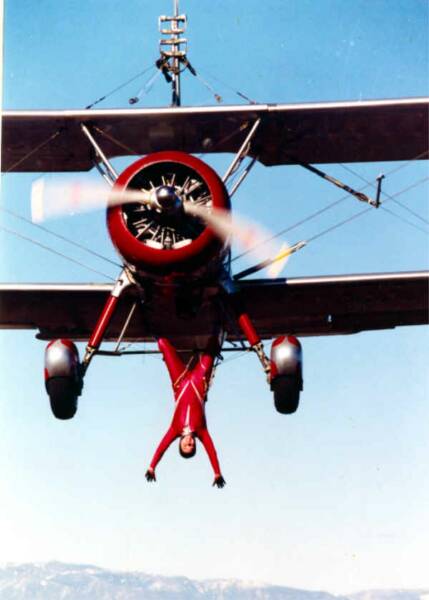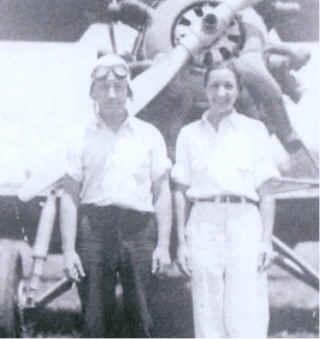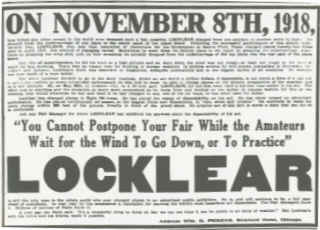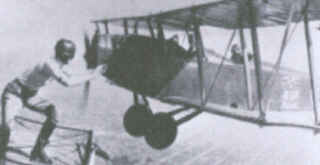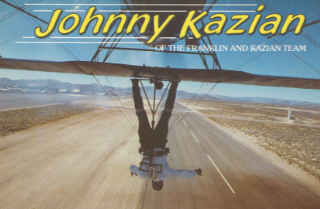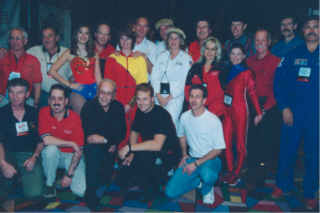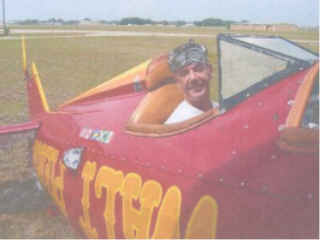Barnstorming bi-plane pilots and their daring stuntmen caught America's imagination just as aviation was taking flight. They were the original ambassadors of flight giving regular folk a chance to see their world from a bird's eye view. This was the 1920's, flappers danced the Charleston. Behind the doors of the speakeasys, underground clubs that offered illegal booze so it was important to speak softly or "easy", champagne flowed and everyone lived like they were immortal.
How did this all start? Let's back up in time a bit. The first powered flight was in 1903 by Orville Wright, the younger of the Wright brothers. At that time everyone was racing to be the first in the air. Ideas and inventions abounded. A short decade later the airplane in its' many configurations made a sensation at expositions, air races, and "airfairs." Known as those magnificent men and their flying machines' they wowed audiences and captured the ladies' hearts.
WWI erupted and this is where wingwalking takes root.
The first wingwalker to perform daring stunts was a 26 year old Ormer Locklear. Legend has it that he first climbed out onto the lower wings during his pilot training in the Army Air Service during World War One. Undaunted and clearly bitten by the wingwalking bug, Ormer just climbed out of the cockpit onto the wings in flight whenever there was a mechanical issue and fixed the problem.
Necessity gave way to showmanship and on November 8, 1918, Locklear wowed the crowd at Barron Field, Texas, with his dare devil wingwalking stunts.
After WWI, pilots came home, still flushed with adrenaline from living life on the edge. They found ways to buy planes, usually a Jenny, and to finance their adventure of flying they hopped from town to town giving rides. They landed in the nicest field they could find often with a barn in it, hence the name BARNSTORMERS. To let everyone in town know they were there, they created little dramas like flying down main street, "loop de looping," and the big attraction - flying with a wingwalker out on the wing, often one of the pilots themselves.
Ormer Locklear lead the charge with his plane to plane transfer and many followed. His female equivalent, the first woman to switch planes in the air, was Ethal Dare.
Some of the many aerialists to make a name for themselves were Tiny Broberick, Gladys Ingles, Eddie Angel, Clyde Pangborn, Lillian Boyer, Jack Shack, Al Wilson, Fronty Nichols, Spider Matlock, Gladys Roy, Ivan Unger, Jessie Woods, Charles Lindbergh and Mabel Cody, niece of Buffalo Bill Cody.
Flying circuses formed and they featured many of these stunt people. Promoters would herald the way with posters hyping up the danger and the new celebrities would perform.
Some famous early flying circuses or troops were The Gates Flying Circus, the Flying Aces Air Circus (Jimmy and Jessie Woods), The 13 Black Cats, The Five Blackbirds (an all African American team), Mabel Cody's Flying Circus, Bugs McGowen's Flying Circus, and a troop run by Douglas Davis.
The Gates Flying Circus is perhaps the organization that made the most impression on the public. In one day alone they gave 980 rides. This was done by pilot Bill Brooks at the Stuebenville Airshow in Ohio. Their one dollar joy ride was a sensation.
Others charged a penny per pound.
The stock market crash in 1929 folded many of the more prominent flying circuses, like the Gates Flying Circus. Smaller operations like the Flying Aces with Jimmy and Jessie Woods continued until the 1938 Air Commerce Act required them to fly at an altitude of 1,500 feet and wear a parachute. The CAA granted one waiver to the Fordon-Brown National Air Show which lasted until 1940 and America focused on World War Two.
Jessie Woods explained "They started making it harder and harder for us ....They made the waivers that we had to get so outlandish that you could not just put on an airshow and obey the rules."
The golden age of barnstorming came to a standstill during WWII.
After the war, undaunted by the rules, creative and energetic young talent took to the skies. Teenager Cliff Rose, who later became a premier stuntman in Hollywood, made history with his"batwing death spiral." Out of Long Beach, California, Cliff performed parachute jumps at 400 feet. He would pull the rip cord of his chute even before he let go of the Stearman. His pilot paid him an extra $50 or $60 to hit the target in front of the audience. Cliff said it was like stealing candy from a baby, "at that height how could one miss."
About that same time after they served their country in World War II, Duane Cole and his brothers formed the Cole Brothers Flying Circus. His first two wingwalkers were Byron Bryner and Merle Torrance. Initially the men would stand on the top wing with their feet attached to the center section and cables around their waist. In 1950 After Merle broke both his ankles and his knees collapsed from standing up on the top wing while the plane was performing aerobatics, the first wingwalk stand was built. Other wing riders were Lloyd Stoner, Dave Turner, Eldon Peters, and Edward Tate. The ladies, Donna Vandemark and Judy Cole, joined the entertainment in 1957. By 1963 Marion Cole sold his Stearman to Bill Adams and Judy Cole continued her act on the wing. The other teams to boast a wingwalker was Harold Krier flying a Great Lakes with stuntman Red Grant.
Aerial acts inspired others and Terry Holmes, Judy Cole's cousin, teamed with a Californian crop duster pilot Bud Fountain and Clyde Parsons to form the "Gold Coast Air Shows." In the northeast Rod Jocelyn and Bob Trauger fascinated crowds and performing on the Atlantic coast form jersey to Florida was Mel Robinson with Shirley Stafford atop his Stearman.
By 1968 most of these acts had retired and a new generation of wingwalkers took the stage. Walt Pierce of American Barnstormer and his wife Sandi bought their Stearman. Walt is still flying today thrilling crowds with not just one lady on the wing but two, one being his granddaughter.
The showman who really cemented the foundation for all modern day wingwalk airshow acts is Johnny Kazian. He created new and daring stuntwork on planes that were many times more powerful than the ones used in the 1920s and 1930s and he did so without the use of any safety lines. He started in the 1965 and continued innovating new stunts on the wing for four plus decades with airshow greats Joe Huges, Art Scholl, Jimmy Franklin, and Dave Dacy. He generated national (U.S.) interest in wingwalking by performing in shows such as "You asked for it" (four times) and "That's incredible" (three times.) Teaming with movie stunt pilots Frank Tallman and Art Scholl, he invented stunts for movies including "The great Waldo Pepper" and "The stuntman." Today he still makes appearances on the wing as part of three generations of Kazian's wingwalking with pilot Dave Dacy. He has amassed over 3000 hours on the wing performing all around the globe and he continues in inspire wingwalkers today. Wingwalker, Margaret Stivers, says "Johnny set the standard by which we still try and reach for today. He is the greatest."
In the 1980s and 1990s, wingwalking gained momentum. In addition to the mighty Stearman bi-plane, performers began innovating new approaches on different planes like the Waco, Ag Cat, Tiger Moth, Antonov, helicopter, and even an Ultralight. New top wing racks and gear axle trapezes were designed allowing a variety of stuntwork and teams pioneered their own creative style thus paving the way for today's generation of wingwalkers.
Now wingwalking teams are performing around the world and its popularity is soaring. All inspire audiences as well as each other. Each act is unique reflecting the type of plane, pilot, and wingwalker. Wingwalking acts performing today push the boundaries of their sport and art while not forgetting the roots of their barnstorming tradition.


